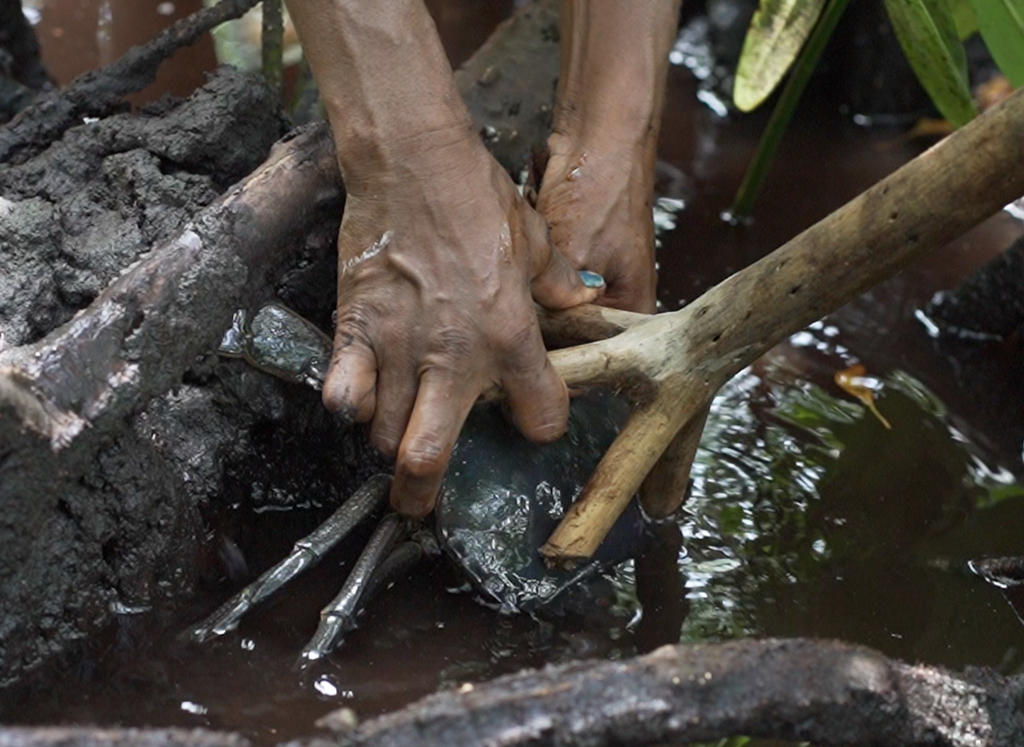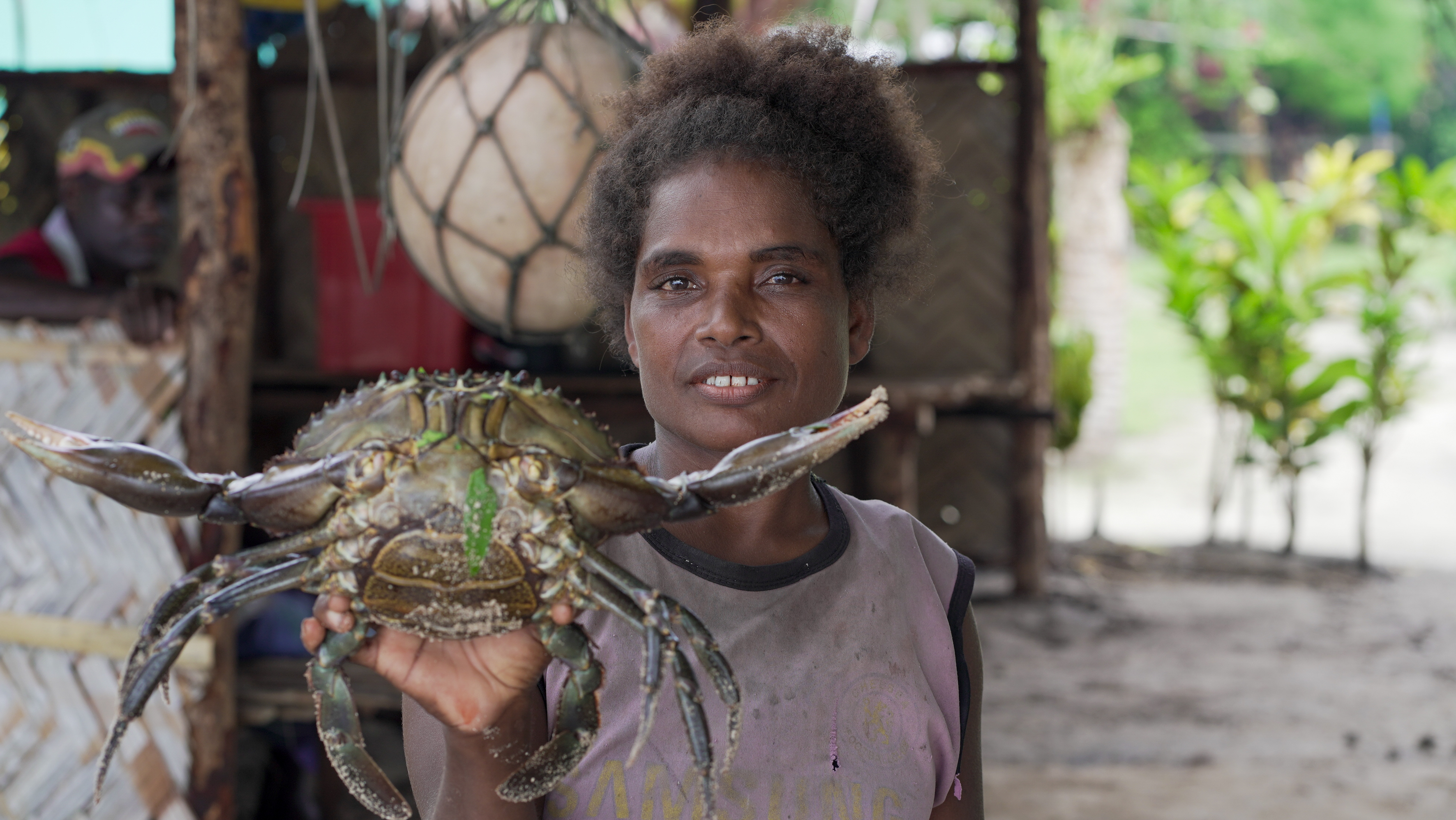Image: © Kalolaine Fainu, SPC
To gain access to full information on mangrove crabs, download the information sheet produced by the LMMA Network and SPC.
If you have noticed a decline in your catches or are concerned about mangrove crab populations, here are some priority actions the community can consider in addition to national regulations:
Fish smart rules
Fishing bans
Banning the taking of female crabs or, at least, berried female crabs;


Size limits
Banning the taking of all crabs smaller than the national minimum size limit (if there is no national size limit, a minimum size of 140 mm width could be imposed by the community);
Protecting marine ecosystems
Protecting the local areas of mangroves and seagrass beds that are essential habitats for mangrove crabs.

Good to know: traps are one of the best methods of catching mangrove crabs
Traps are one of the best ways of catching mangrove crabs as they do not damage the caught crabs, which can therefore be released if they are females or are too small.
Good to know: tabus areas are unlikely to be beneficial for mangrove crabs
Reserves (tabu areas) are unlikely to result in an increase in numbers of local populations of mangrove crabs as females move considerable distances offshore to spawn. This and the fact that the larval stages drift for several weeks suggests that juvenile crabs may settle in areas some distance from the reserve and local fishing areas.
Fishing methods
Mangrove crabs are caught by:
-
Simple hand collection, sometimes with the aid of a hooked stick to remove crabs from their burrows;
-
Spears used at night with light from torches;
-
Long-handled scoop nets used among seagrass beds;
-
Gill nets set at the edge of the mangroves to catch crabs as they move into deeper water;
-
Baited traps and dillies made of string or wire mesh.
Management measures in the region
Many fisheries management regulations have been applied to mangrove crabs, particularly in places where they are valuable in local markets. These measures include quotas or catch limits (a particular number of crabs per day), limiting the number of traps used and the licensing of those selling crabs. These measures are generally not applicable in community-based fisheries.
Measures applicable to all fishing for mangrove crabs include the application of minimum size limits (often between 120 mm and 150 mm shell width), banning the taking of female crabs, banning the taking of berried female crabs, and banning the use of certain fishing methods such as gill nets and spears.
In some countries catching mangrove crabs is prohibited during the reproductive period. Applying this measure relies on having knowledge of the timing of the spawning season in the particular area of concern.
The mangrove or mud crab, Scylla serrata, is found in tropical and sub-tropical inshore areas from Africa to the Pacific Islands. The shell colour varies from a deep, mottled green to very dark brown/purple. Other related species of Scylla may exist in some areas.
Male and female crabs can be distinguished from each other by the shape of the flap (abdomen) on the underside of the crab; the flap is narrow in males and much wider in females.
The mangrove crab is found in muddy areas associated with mangroves and seagrass beds in the tidal mouths of rivers and sheltered bays. The crabs burrow in the mud and generally have a restricted home range (area over which they move to feed).
Mangrove crabs eat small clams, worms, shrimps, barnacles, small fish, plant material and other crabs. They also eat smaller, injured or weak mangrove crabs. Juvenile mangrove crabs are eaten by wading birds and a wide range of fish. Adult crabs have been found in the stomachs of sharks and larger fish.
Mangrove crabs reach reproductive maturity in about 2 years and live for about 3 to 4 years when they can weigh up to 3.5 kg with a shell width of up to 24 cm.
During mating, the male crab transfers sperm packets (spermatophores) to the underside of a soft-shelled female where the sperm is stored for many months. The female releases over a million eggs which are fertilised by the stored sperm. The female (now said to be ‘berried’) carries the eggs for about 12 days. During this period the colour of the eggs changes from bright orange to almost black as the young crabs grow inside.
The female moves offshore where the eggs are released and hatch to become small floating forms (the drifting larval stages) about 1 mm long. These float in the sea for about 3 weeks and drift with currents back to inshore areas.
The final larval stage settles on the sea floor and turns into a miniature adult or juvenile (about 4 mm wide) within 5 to 12 days. Less than one in every thousand of the small floating forms survives to become a juvenile. And less than one in every hundred juveniles survives to become an adult.

To gain access to full information on mangrove crabs, download the information sheet

